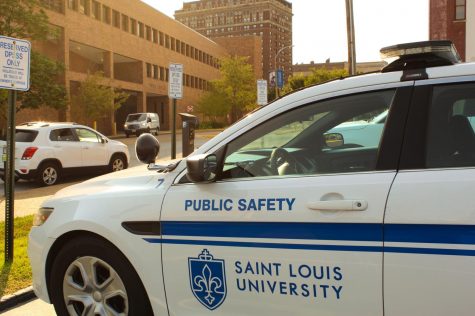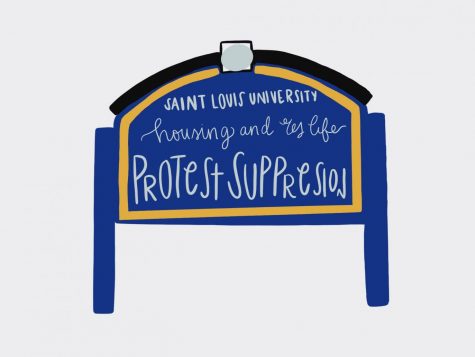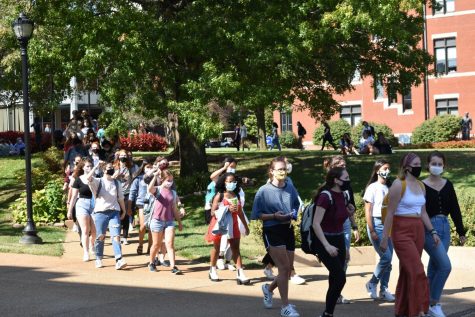Better Together?
The Pros and Cons of Merging St. Louis City and County
The possible merging of the city and county of St. Louis has not come to a vote since before the Voting Rights Act, but may change thanks to the educational work of Better Together St. Louis, a non-profit committed to “fact driven research of fragmentation in the region.” In addition to hosting nine town halls over the coming weeks, the organization presented before a standing-room-only crowd at the law school on Thursday, Oct. 5.
As Kyle Juvers, the Associate Director of Community-Based Studies of Better Together STL explained, since the end of the Civil War, the city of St. Louis has been divorced from the county. Hoping to avoid rural land issues in the county, the city picked the boundary lines and has been divided ever since, with only two attempts to reunite: one in 1926 and the other in 1962. Juvers laid out the economic benefits of a potential merger, including the savings from a more efficient purchasing and administration structure for public services. For instance, rather than each municipal fire department purchasing and servicing equipment and parts, the region as a whole would be better able to leverage for better rates.
Currently, $280 million is paid each year to city executives in the county, such as mayors; $6 million per year to city managers; and $3 million per year to aldermen. A regional approach, says Juvers, would eliminate the need for as many officials, and would potentially save millions.
In addition to the potential savings, Juvers pointed out issues with law enforcement. In the county, some police officers make $10.50 per hour and drive in department vehicles that are uninsured. Many county departments are not internationally accredited, while the St. Louis Metropolitan Police Department is. One possible benefit of the merger may be better equipped and trained officers in the area throughout the county.
One of the harms of municipal fragmentation that Juvers made a point of discussing was issues with transportation. A trip from the airport to the Galleria Mall traverses 15 municipalities and 14 different police departments, meaning a 911 call at any point along the route could go to a different dispatcher who would send a first responder with varying degrees of training. In addition, a driver can be ticketed for the same infraction—such as a broken taillight— multiple times on his or her route to work. Some county municipalities make as much as 66.7 percent of their revenue from their court system, including fines paid by motorists.
On the legal end, there are 43 municipalities, some of which consists of attorneys, prosecutors and judges whom all belong to the same law firm. Juvers speculated that, in effect, this would leave a person with no other option but to hire an associate from the same firm to represent him or her in court.
In addition, the IRS tax book consists of some 9,000 pages of tax law, and the municipal laws of St. Louis County consist of about 32,000 pages and include archaic laws such as requiring a permit to hold a dance in Berkley. A merger between the city of St. Louis and the county of St. Louis may help cut down on inefficient or outdated laws in the county.
Transparency can also be an issue in the current separated county and city system. With 131 city council meetings each month, it can be difficult for the press and citizens to accurately determine what is going on in any one municipality or the region as a whole. Juvers finds the current fragmentation of municipalities the source of internal competition and the disparity in services within the region, making it difficult to form a united vision and attract businesses, such as Amazon, or aid in the financing of stadiums. Due to the current structure, municipalities actually compete with one another, rather than uniting as a region.
Another practical effect would be the combining of crime statistics, which could help attract outside businesses, effectively lowering St. Louis City’s current standing as the second most dangerous city in America, according to Forbes Magazine.
Opponents of the merger of city and county worry about the effect a merger would have on citizens’ relationships with their elected officials. In many smaller communities, elected officials can form close relationships and work with their constituents. A merge between city and county may damage that relationship, resulting in citizens losing a way to make their voice heard. The current separation between the city and the county gives citizens an option on what type of the community they would like to live in and how much they want to be involved with their public servants.
Opponents of the merger also worry about the county having to pay the costs of the city of St. Louis, such as government deficits and underfunded pensions. As a 501(c)(3) non-profit, Better Together cannot actually advocate for the proposal of the city and county merger, but can only educate the public on the topic. Ultimately, it will be up to the people to decide on the future of both the city of St. Louis and the St. Louis County.
Your donation will support the student journalists of Saint Louis University. Your contribution will help us cover our annual website hosting costs.













Jennifer Jeffrey • Jan 23, 2019 at 10:55 pm
What happens to the current school districts of the municipality if those municipal goats go away? Do we have one big district for the county? Frankly that would ruin home prices in the better districts.